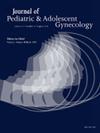13. 青少年左炔诺孕酮宫内节育器使用体验及满意度
IF 1.7
4区 医学
Q3 OBSTETRICS & GYNECOLOGY
引用次数: 0
摘要
背景:在青少年中,美国妇产科学院推荐的一线避孕方法是:妇科(ACOG)是长效可逆避孕(LARC),如宫内节育器,但他们很少使用。在许多研究中,提供者报告了由于患者缺乏胎次和年龄而犹豫不决。本研究旨在探讨青少年使用左炔诺孕酮宫内节育器的体验和满意度,并比较现有品牌(Skyla, Kyleena和Mirena)。方法回顾性分析符合纳入标准的患者(女性10-21岁,2011-2021年间植入宫内节育器)。通过电子邮件向患者发送一份调查问卷,包括植入时的年龄、宫内节育器品牌、植入原因、副作用、装置延续、满意度(1-10)等。结果用于确定总体和具体的满意度,以及不同品牌/类型的宫内节育器满意度是否不同。进行描述性统计分析。结果共调查102人。总体满意度在左炔诺孕酮宫内节育器之间无统计学差异(p = 0.2004),个体对其宫内节育器体验总体满意。在本研究中,三种品牌的宫内节育器置入后出现明显疼痛的个体比例差异有统计学意义(p = 0.0282)。Kyleena有明显插入后疼痛的个体比例最高(65.12%),其次是Skyla(62.50%)和Mirena(54.17%)。结论larcs是青少年首选避孕药物。放置左炔诺孕酮宫内节育器的青少年总体上有积极的体验,并对他们的决定感到满意。左炔诺孕酮宫内节育器的满意度无显著差异。本文章由计算机程序翻译,如有差异,请以英文原文为准。
13. Adolescent Levonorgestrel Intrauterine Device Experience and Satisfaction
Background
In adolescents, the first line contraception method recommended by the American College of Obstetricians & Gynecologists (ACOG) is long-acting reversible contraception (LARC) such as an IUD, yet they are rarely utilized. In numerous studies providers have reported hesitation due to patient's lack of parity and age. This study aimed to explore the experience and satisfaction of adolescents with levonorgestrel IUDs, as well as compare between the available brands (Skyla, Kyleena, and Mirena).
Methods
A retrospective chart review was performed to attain patients meeting inclusion criteria (females 10-21 with IUD insertion between 2011-2021). Patients were emailed a survey obtaining age at insertion, IUD brand, reason for IUD insertion, side effects, device continuation, rate of satisfaction (1-10), et cetera. Results were used to determine satisfaction rates, overall and specific, and if satisfaction varied between IUD brands/types. Descriptive statistical analysis was performed.
Results
A total of 102 individuals were surveyed. Overall satisfaction was not statistically different (p = 0.2004) between levonorgestrel IUDs, with individuals overall satisfied with their IUD experience. In this study there was a statistically significant difference in the proportion of individuals experiencing significant post-insertion pain among the three IUD brands (p = 0.0282). Kyleena has the highest percentage of individuals experiencing significant post-insertion pain (65.12%), followed by Skyla (62.50%) and Mirena (54.17%).
Conclusions
LARCs are the first-line recommendation for contraception in adolescents. Adolescents who have levonorgestrel IUDs placed have an overall positive experience and are satisfied with their decision. There is no significant difference in satisfaction between levonorgestrel IUDs.
求助全文
通过发布文献求助,成功后即可免费获取论文全文。
去求助
来源期刊
CiteScore
3.90
自引率
11.10%
发文量
251
审稿时长
57 days
期刊介绍:
Journal of Pediatric and Adolescent Gynecology includes all aspects of clinical and basic science research in pediatric and adolescent gynecology. The Journal draws on expertise from a variety of disciplines including pediatrics, obstetrics and gynecology, reproduction and gynecology, reproductive and pediatric endocrinology, genetics, and molecular biology.
The Journal of Pediatric and Adolescent Gynecology features original studies, review articles, book and literature reviews, letters to the editor, and communications in brief. It is an essential resource for the libraries of OB/GYN specialists, as well as pediatricians and primary care physicians.

 求助内容:
求助内容: 应助结果提醒方式:
应助结果提醒方式:


